Fair Outcomes: Australia's Employment Relations During COVID-19
VerifiedAdded on 2022/12/23
|8
|1685
|32
Essay
AI Summary
This essay examines the Australian employment relations system's response to the COVID-19 pandemic, focusing on the extent to which it delivered fair outcomes for both employees and employers. It begins by defining employment relations and outlining the key elements of the Australian National Employment Relations System, including the role of the Fair Work Commission and the Fair Work Ombudsman. The main body analyzes how the system, through measures like job seeker wage subsidies, leave entitlements, employer stand-down provisions, employee protection from termination, and flexible working arrangements, aimed to mitigate the pandemic's impact. The essay highlights how these measures, alongside the Fair Work Commission and Ombudsman, facilitated a balance between protecting employee rights and supporting business continuity. It concludes by emphasizing the importance of adapting employment relations frameworks to address unforeseen crises. References to relevant literature are also included.
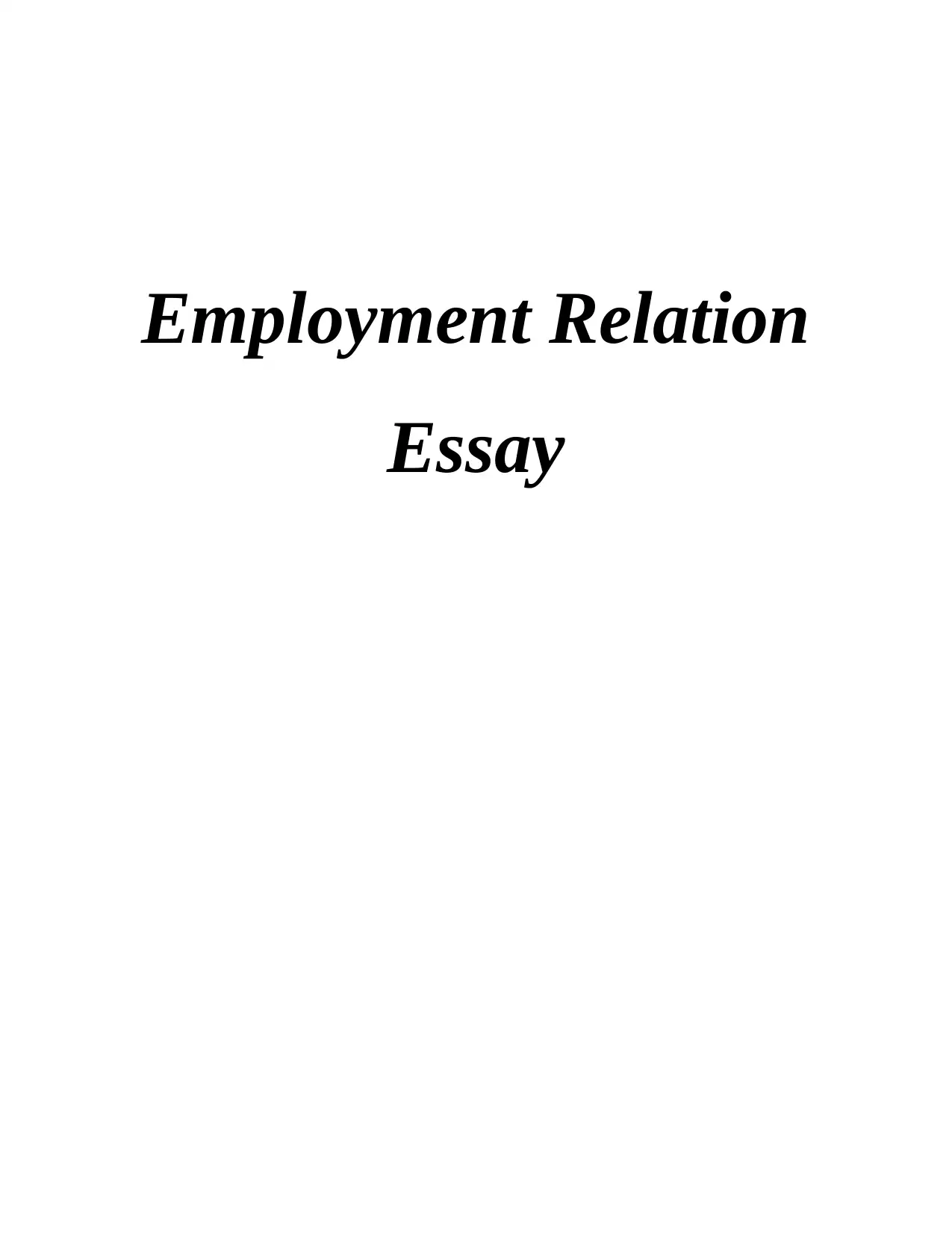
Employment Relation
Essay
Essay
Paraphrase This Document
Need a fresh take? Get an instant paraphrase of this document with our AI Paraphraser
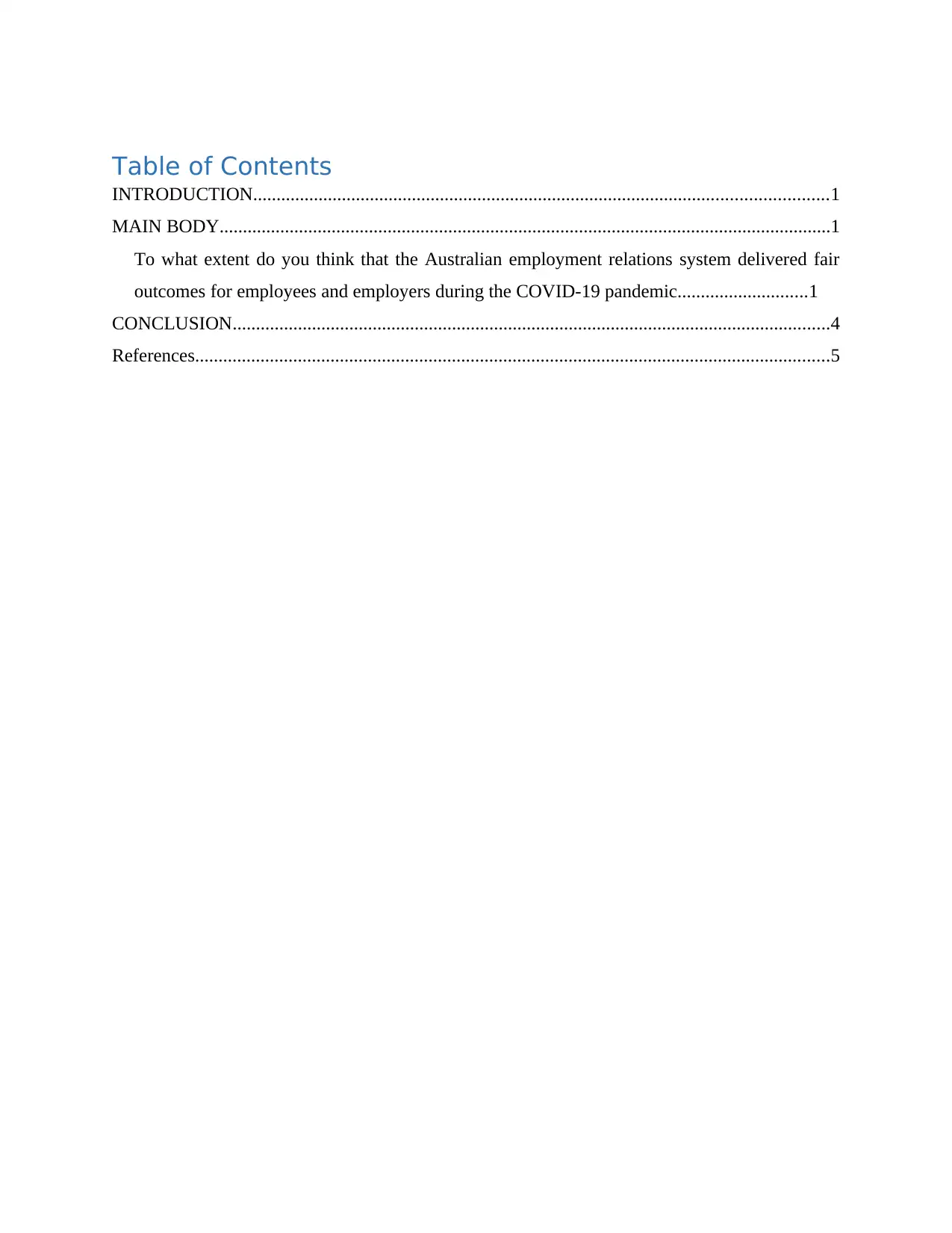
Table of Contents
INTRODUCTION...........................................................................................................................1
MAIN BODY...................................................................................................................................1
To what extent do you think that the Australian employment relations system delivered fair
outcomes for employees and employers during the COVID-19 pandemic............................1
CONCLUSION................................................................................................................................4
References........................................................................................................................................5
INTRODUCTION...........................................................................................................................1
MAIN BODY...................................................................................................................................1
To what extent do you think that the Australian employment relations system delivered fair
outcomes for employees and employers during the COVID-19 pandemic............................1
CONCLUSION................................................................................................................................4
References........................................................................................................................................5

⊘ This is a preview!⊘
Do you want full access?
Subscribe today to unlock all pages.

Trusted by 1+ million students worldwide
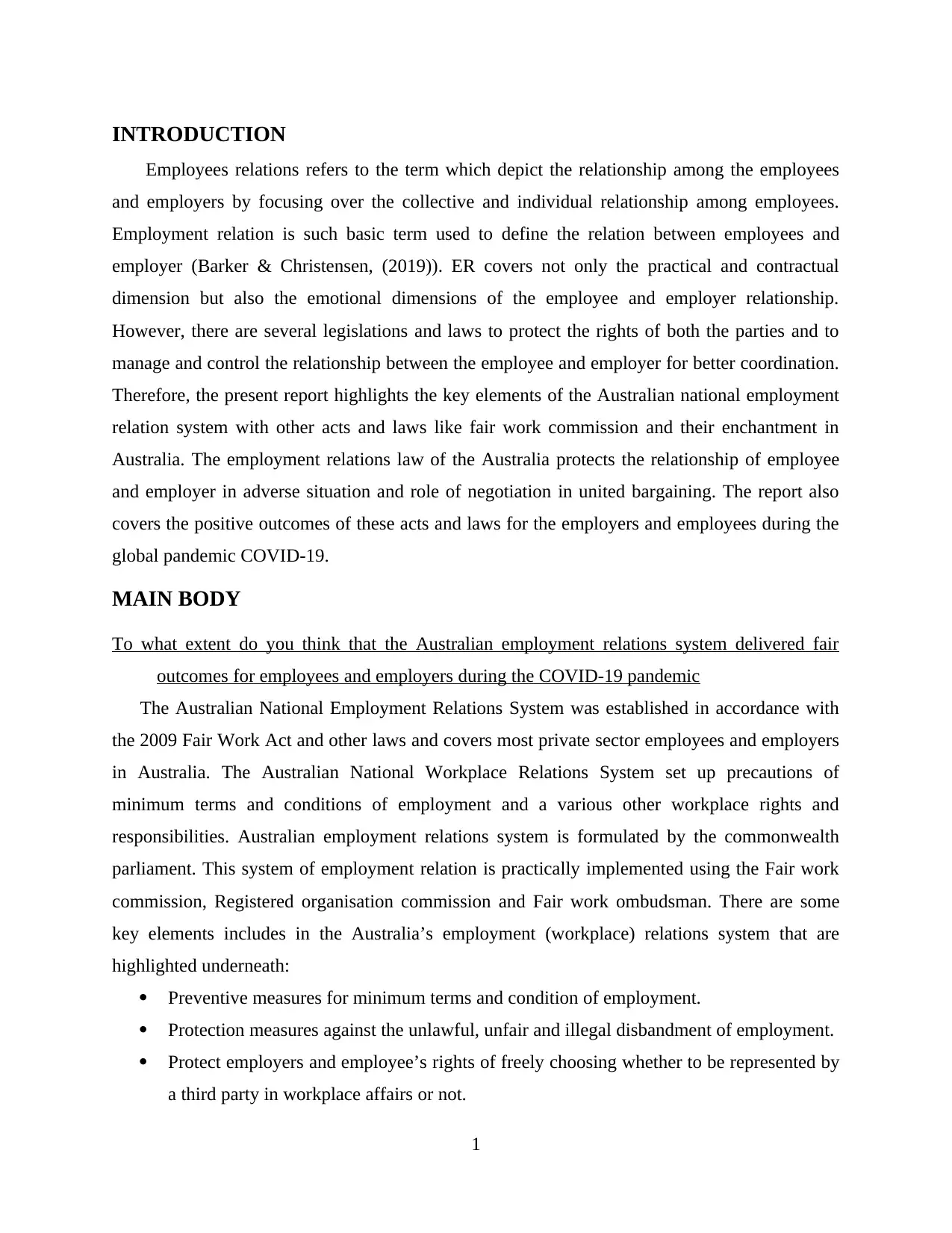
INTRODUCTION
Employees relations refers to the term which depict the relationship among the employees
and employers by focusing over the collective and individual relationship among employees.
Employment relation is such basic term used to define the relation between employees and
employer (Barker & Christensen, (2019)). ER covers not only the practical and contractual
dimension but also the emotional dimensions of the employee and employer relationship.
However, there are several legislations and laws to protect the rights of both the parties and to
manage and control the relationship between the employee and employer for better coordination.
Therefore, the present report highlights the key elements of the Australian national employment
relation system with other acts and laws like fair work commission and their enchantment in
Australia. The employment relations law of the Australia protects the relationship of employee
and employer in adverse situation and role of negotiation in united bargaining. The report also
covers the positive outcomes of these acts and laws for the employers and employees during the
global pandemic COVID-19.
MAIN BODY
To what extent do you think that the Australian employment relations system delivered fair
outcomes for employees and employers during the COVID-19 pandemic
The Australian National Employment Relations System was established in accordance with
the 2009 Fair Work Act and other laws and covers most private sector employees and employers
in Australia. The Australian National Workplace Relations System set up precautions of
minimum terms and conditions of employment and a various other workplace rights and
responsibilities. Australian employment relations system is formulated by the commonwealth
parliament. This system of employment relation is practically implemented using the Fair work
commission, Registered organisation commission and Fair work ombudsman. There are some
key elements includes in the Australia’s employment (workplace) relations system that are
highlighted underneath:
Preventive measures for minimum terms and condition of employment.
Protection measures against the unlawful, unfair and illegal disbandment of employment.
Protect employers and employee’s rights of freely choosing whether to be represented by
a third party in workplace affairs or not.
1
Employees relations refers to the term which depict the relationship among the employees
and employers by focusing over the collective and individual relationship among employees.
Employment relation is such basic term used to define the relation between employees and
employer (Barker & Christensen, (2019)). ER covers not only the practical and contractual
dimension but also the emotional dimensions of the employee and employer relationship.
However, there are several legislations and laws to protect the rights of both the parties and to
manage and control the relationship between the employee and employer for better coordination.
Therefore, the present report highlights the key elements of the Australian national employment
relation system with other acts and laws like fair work commission and their enchantment in
Australia. The employment relations law of the Australia protects the relationship of employee
and employer in adverse situation and role of negotiation in united bargaining. The report also
covers the positive outcomes of these acts and laws for the employers and employees during the
global pandemic COVID-19.
MAIN BODY
To what extent do you think that the Australian employment relations system delivered fair
outcomes for employees and employers during the COVID-19 pandemic
The Australian National Employment Relations System was established in accordance with
the 2009 Fair Work Act and other laws and covers most private sector employees and employers
in Australia. The Australian National Workplace Relations System set up precautions of
minimum terms and conditions of employment and a various other workplace rights and
responsibilities. Australian employment relations system is formulated by the commonwealth
parliament. This system of employment relation is practically implemented using the Fair work
commission, Registered organisation commission and Fair work ombudsman. There are some
key elements includes in the Australia’s employment (workplace) relations system that are
highlighted underneath:
Preventive measures for minimum terms and condition of employment.
Protection measures against the unlawful, unfair and illegal disbandment of employment.
Protect employers and employee’s rights of freely choosing whether to be represented by
a third party in workplace affairs or not.
1
Paraphrase This Document
Need a fresh take? Get an instant paraphrase of this document with our AI Paraphraser
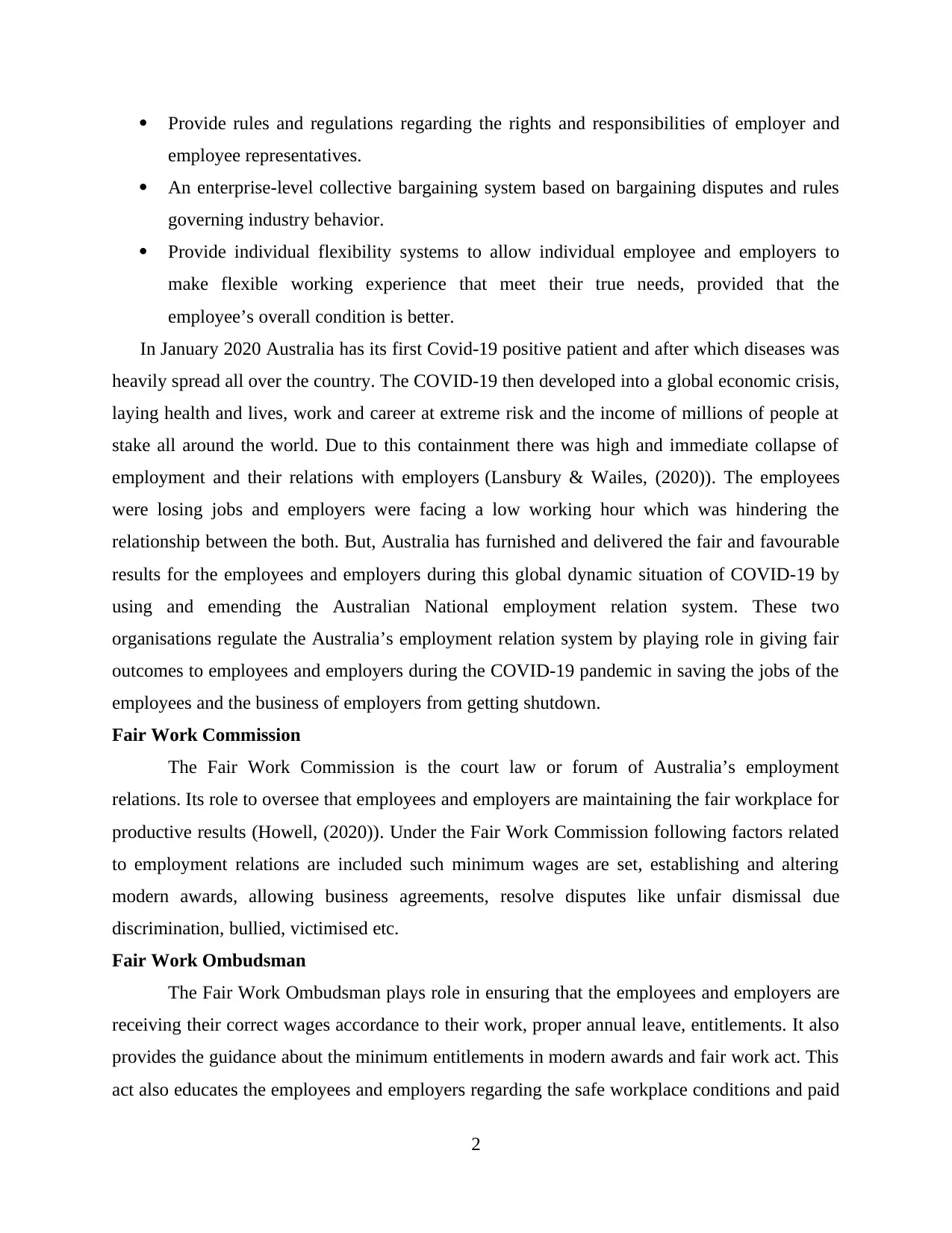
Provide rules and regulations regarding the rights and responsibilities of employer and
employee representatives.
An enterprise-level collective bargaining system based on bargaining disputes and rules
governing industry behavior.
Provide individual flexibility systems to allow individual employee and employers to
make flexible working experience that meet their true needs, provided that the
employee’s overall condition is better.
In January 2020 Australia has its first Covid-19 positive patient and after which diseases was
heavily spread all over the country. The COVID-19 then developed into a global economic crisis,
laying health and lives, work and career at extreme risk and the income of millions of people at
stake all around the world. Due to this containment there was high and immediate collapse of
employment and their relations with employers (Lansbury & Wailes, (2020)). The employees
were losing jobs and employers were facing a low working hour which was hindering the
relationship between the both. But, Australia has furnished and delivered the fair and favourable
results for the employees and employers during this global dynamic situation of COVID-19 by
using and emending the Australian National employment relation system. These two
organisations regulate the Australia’s employment relation system by playing role in giving fair
outcomes to employees and employers during the COVID-19 pandemic in saving the jobs of the
employees and the business of employers from getting shutdown.
Fair Work Commission
The Fair Work Commission is the court law or forum of Australia’s employment
relations. Its role to oversee that employees and employers are maintaining the fair workplace for
productive results (Howell, (2020)). Under the Fair Work Commission following factors related
to employment relations are included such minimum wages are set, establishing and altering
modern awards, allowing business agreements, resolve disputes like unfair dismissal due
discrimination, bullied, victimised etc.
Fair Work Ombudsman
The Fair Work Ombudsman plays role in ensuring that the employees and employers are
receiving their correct wages accordance to their work, proper annual leave, entitlements. It also
provides the guidance about the minimum entitlements in modern awards and fair work act. This
act also educates the employees and employers regarding the safe workplace conditions and paid
2
employee representatives.
An enterprise-level collective bargaining system based on bargaining disputes and rules
governing industry behavior.
Provide individual flexibility systems to allow individual employee and employers to
make flexible working experience that meet their true needs, provided that the
employee’s overall condition is better.
In January 2020 Australia has its first Covid-19 positive patient and after which diseases was
heavily spread all over the country. The COVID-19 then developed into a global economic crisis,
laying health and lives, work and career at extreme risk and the income of millions of people at
stake all around the world. Due to this containment there was high and immediate collapse of
employment and their relations with employers (Lansbury & Wailes, (2020)). The employees
were losing jobs and employers were facing a low working hour which was hindering the
relationship between the both. But, Australia has furnished and delivered the fair and favourable
results for the employees and employers during this global dynamic situation of COVID-19 by
using and emending the Australian National employment relation system. These two
organisations regulate the Australia’s employment relation system by playing role in giving fair
outcomes to employees and employers during the COVID-19 pandemic in saving the jobs of the
employees and the business of employers from getting shutdown.
Fair Work Commission
The Fair Work Commission is the court law or forum of Australia’s employment
relations. Its role to oversee that employees and employers are maintaining the fair workplace for
productive results (Howell, (2020)). Under the Fair Work Commission following factors related
to employment relations are included such minimum wages are set, establishing and altering
modern awards, allowing business agreements, resolve disputes like unfair dismissal due
discrimination, bullied, victimised etc.
Fair Work Ombudsman
The Fair Work Ombudsman plays role in ensuring that the employees and employers are
receiving their correct wages accordance to their work, proper annual leave, entitlements. It also
provides the guidance about the minimum entitlements in modern awards and fair work act. This
act also educates the employees and employers regarding the safe workplace conditions and paid
2
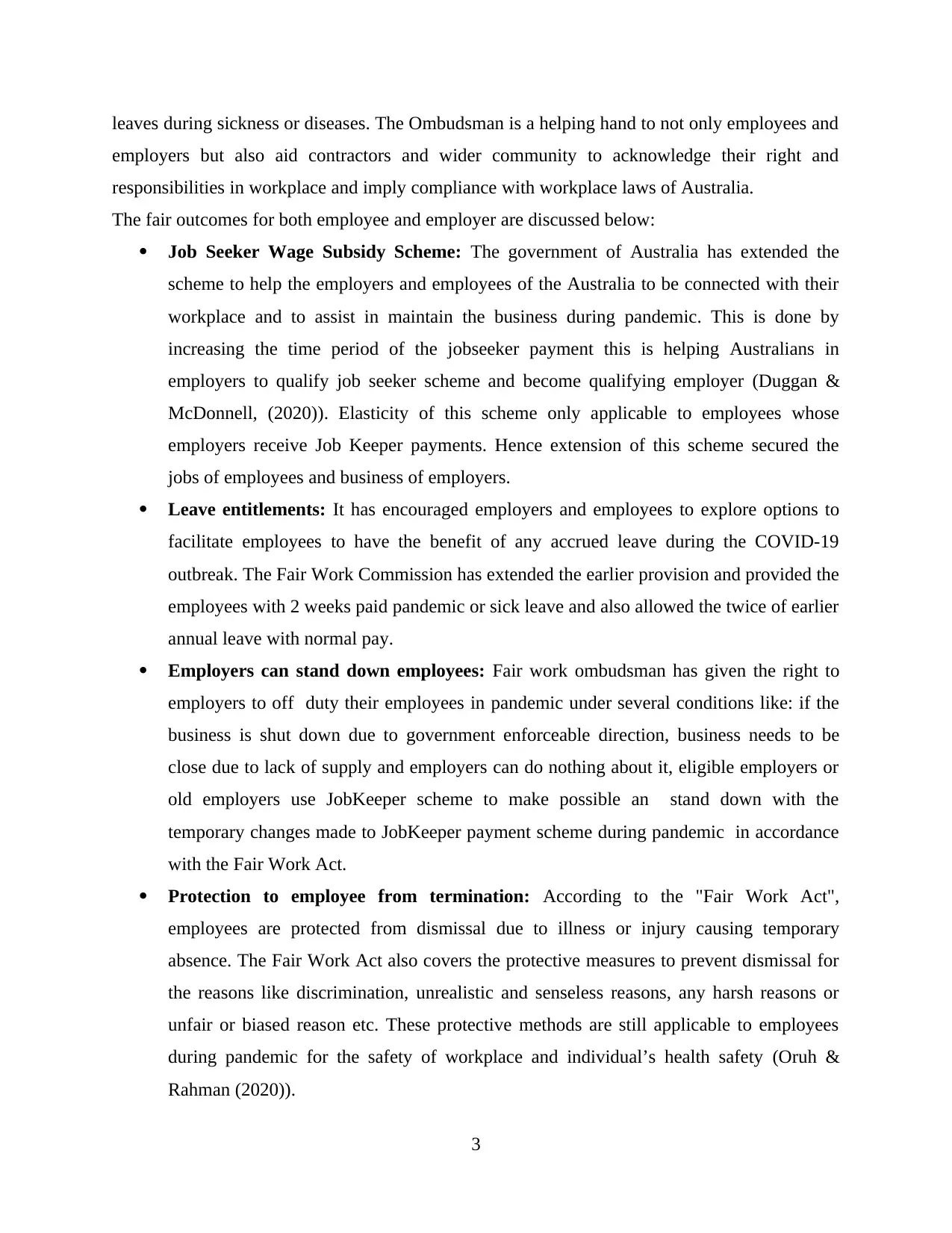
leaves during sickness or diseases. The Ombudsman is a helping hand to not only employees and
employers but also aid contractors and wider community to acknowledge their right and
responsibilities in workplace and imply compliance with workplace laws of Australia.
The fair outcomes for both employee and employer are discussed below:
Job Seeker Wage Subsidy Scheme: The government of Australia has extended the
scheme to help the employers and employees of the Australia to be connected with their
workplace and to assist in maintain the business during pandemic. This is done by
increasing the time period of the jobseeker payment this is helping Australians in
employers to qualify job seeker scheme and become qualifying employer (Duggan &
McDonnell, (2020)). Elasticity of this scheme only applicable to employees whose
employers receive Job Keeper payments. Hence extension of this scheme secured the
jobs of employees and business of employers.
Leave entitlements: It has encouraged employers and employees to explore options to
facilitate employees to have the benefit of any accrued leave during the COVID-19
outbreak. The Fair Work Commission has extended the earlier provision and provided the
employees with 2 weeks paid pandemic or sick leave and also allowed the twice of earlier
annual leave with normal pay.
Employers can stand down employees: Fair work ombudsman has given the right to
employers to off duty their employees in pandemic under several conditions like: if the
business is shut down due to government enforceable direction, business needs to be
close due to lack of supply and employers can do nothing about it, eligible employers or
old employers use JobKeeper scheme to make possible an stand down with the
temporary changes made to JobKeeper payment scheme during pandemic in accordance
with the Fair Work Act.
Protection to employee from termination: According to the "Fair Work Act",
employees are protected from dismissal due to illness or injury causing temporary
absence. The Fair Work Act also covers the protective measures to prevent dismissal for
the reasons like discrimination, unrealistic and senseless reasons, any harsh reasons or
unfair or biased reason etc. These protective methods are still applicable to employees
during pandemic for the safety of workplace and individual’s health safety (Oruh &
Rahman (2020)).
3
employers but also aid contractors and wider community to acknowledge their right and
responsibilities in workplace and imply compliance with workplace laws of Australia.
The fair outcomes for both employee and employer are discussed below:
Job Seeker Wage Subsidy Scheme: The government of Australia has extended the
scheme to help the employers and employees of the Australia to be connected with their
workplace and to assist in maintain the business during pandemic. This is done by
increasing the time period of the jobseeker payment this is helping Australians in
employers to qualify job seeker scheme and become qualifying employer (Duggan &
McDonnell, (2020)). Elasticity of this scheme only applicable to employees whose
employers receive Job Keeper payments. Hence extension of this scheme secured the
jobs of employees and business of employers.
Leave entitlements: It has encouraged employers and employees to explore options to
facilitate employees to have the benefit of any accrued leave during the COVID-19
outbreak. The Fair Work Commission has extended the earlier provision and provided the
employees with 2 weeks paid pandemic or sick leave and also allowed the twice of earlier
annual leave with normal pay.
Employers can stand down employees: Fair work ombudsman has given the right to
employers to off duty their employees in pandemic under several conditions like: if the
business is shut down due to government enforceable direction, business needs to be
close due to lack of supply and employers can do nothing about it, eligible employers or
old employers use JobKeeper scheme to make possible an stand down with the
temporary changes made to JobKeeper payment scheme during pandemic in accordance
with the Fair Work Act.
Protection to employee from termination: According to the "Fair Work Act",
employees are protected from dismissal due to illness or injury causing temporary
absence. The Fair Work Act also covers the protective measures to prevent dismissal for
the reasons like discrimination, unrealistic and senseless reasons, any harsh reasons or
unfair or biased reason etc. These protective methods are still applicable to employees
during pandemic for the safety of workplace and individual’s health safety (Oruh &
Rahman (2020)).
3
⊘ This is a preview!⊘
Do you want full access?
Subscribe today to unlock all pages.

Trusted by 1+ million students worldwide

Alternative working hours helping employers: Due to COVID-19 the working
arrangements of many employees where changed from office to work from home and
change in working hours and duties. Employers within the fair work jobkeeper scheme
were allowed to reduce or change the working hours, duties and location of the
employees.
Working compensation for employees and employers with Covid-19 contract- The
workers in Australia with safe work Australia law under worker compensation scheme
were benefited and allowed to compensate the work in case of injuries or any sickness
due to disease (Anner, Fischer-Daly & Maffie, (2020)). The employees and employers
are leveraged with the employment relations system in getting flexibility in arrangement
of the work and workplace at home during the pandemic.
CONCLUSION
It is concluded from the above essay of employment relations that it is very essential for
every country to enchant and implement the laws related to right of labour and employer for the
positive economic growth and prosperity. The Australian fair workplace act and the employment
relations system is the example for the other countries to adopt such legislations to satisfy and
fulfil the needs of employer and employee of their nation. It is also observed that pandemic like
COVID-19 or any other adverse situation requires the amendment in existing laws to cope up
and overcome from the consequences of the complex situations. Hence, employment relations
are necessary to be maintained for the nation’s economy.
4
arrangements of many employees where changed from office to work from home and
change in working hours and duties. Employers within the fair work jobkeeper scheme
were allowed to reduce or change the working hours, duties and location of the
employees.
Working compensation for employees and employers with Covid-19 contract- The
workers in Australia with safe work Australia law under worker compensation scheme
were benefited and allowed to compensate the work in case of injuries or any sickness
due to disease (Anner, Fischer-Daly & Maffie, (2020)). The employees and employers
are leveraged with the employment relations system in getting flexibility in arrangement
of the work and workplace at home during the pandemic.
CONCLUSION
It is concluded from the above essay of employment relations that it is very essential for
every country to enchant and implement the laws related to right of labour and employer for the
positive economic growth and prosperity. The Australian fair workplace act and the employment
relations system is the example for the other countries to adopt such legislations to satisfy and
fulfil the needs of employer and employee of their nation. It is also observed that pandemic like
COVID-19 or any other adverse situation requires the amendment in existing laws to cope up
and overcome from the consequences of the complex situations. Hence, employment relations
are necessary to be maintained for the nation’s economy.
4
Paraphrase This Document
Need a fresh take? Get an instant paraphrase of this document with our AI Paraphraser

References
Books and Journals
Anner, M., Fischer-Daly, M., & Maffie, M. (2020). Fissured Employment and Network
Bargaining: Emerging Employment Relations Dynamics in a Contingent World of
Work. ILR Review, 0019793920964180.
Barker, K., & Christensen, K. (Eds.). (2019). Contingent work: American employment relations
in transition. Cornell University Press.
Duggan, J & McDonnell, A. (2020). Algorithmic management and app‐work in the gig
economy: A research agenda for employment relations and HRM. Human Resource
Management Journal, 30(1), 114-132.
Howell, C. (2020). Rethinking the role of the state in employment relations for a neoliberal
era. ILR Review, 0019793920904663.
Lansbury, R. D & Wailes, N. (Eds.). (2020). International and comparative employment
relations: National regulation, global changes. Routledge.
Oruh, E. S & Rahman, M. (2020). Investigating the relationship between managerialist
employment relations and employee turnover intention. Employee Relations: The
International Journal.
5
Books and Journals
Anner, M., Fischer-Daly, M., & Maffie, M. (2020). Fissured Employment and Network
Bargaining: Emerging Employment Relations Dynamics in a Contingent World of
Work. ILR Review, 0019793920964180.
Barker, K., & Christensen, K. (Eds.). (2019). Contingent work: American employment relations
in transition. Cornell University Press.
Duggan, J & McDonnell, A. (2020). Algorithmic management and app‐work in the gig
economy: A research agenda for employment relations and HRM. Human Resource
Management Journal, 30(1), 114-132.
Howell, C. (2020). Rethinking the role of the state in employment relations for a neoliberal
era. ILR Review, 0019793920904663.
Lansbury, R. D & Wailes, N. (Eds.). (2020). International and comparative employment
relations: National regulation, global changes. Routledge.
Oruh, E. S & Rahman, M. (2020). Investigating the relationship between managerialist
employment relations and employee turnover intention. Employee Relations: The
International Journal.
5
1 out of 8
Related Documents
Your All-in-One AI-Powered Toolkit for Academic Success.
+13062052269
info@desklib.com
Available 24*7 on WhatsApp / Email
![[object Object]](/_next/static/media/star-bottom.7253800d.svg)
Unlock your academic potential
Copyright © 2020–2025 A2Z Services. All Rights Reserved. Developed and managed by ZUCOL.





